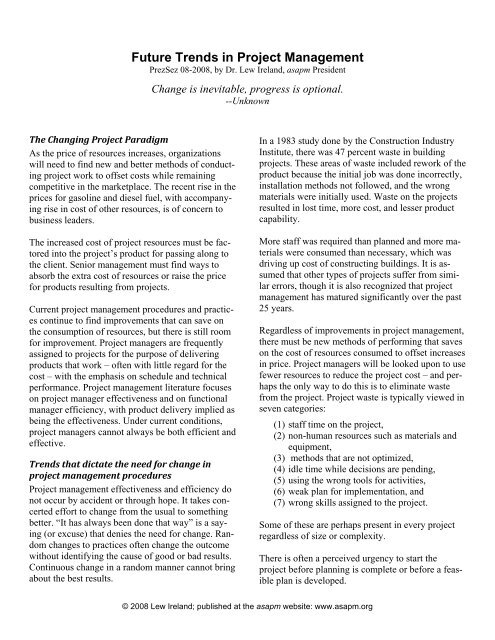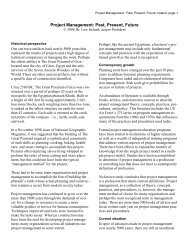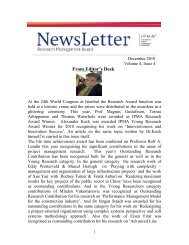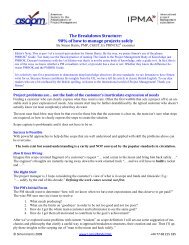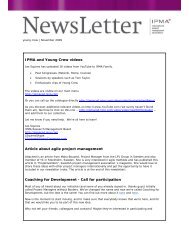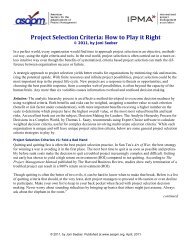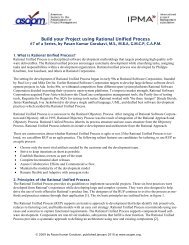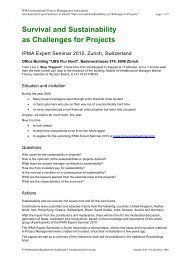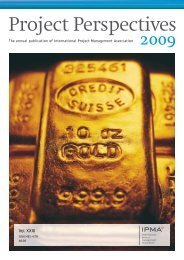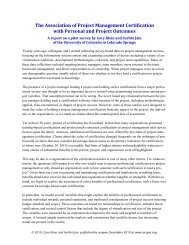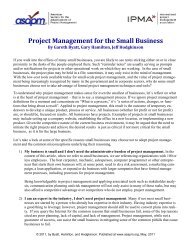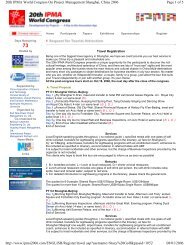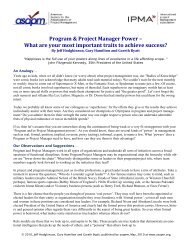Future Trends in Project Management - asapm
Future Trends in Project Management - asapm
Future Trends in Project Management - asapm
Create successful ePaper yourself
Turn your PDF publications into a flip-book with our unique Google optimized e-Paper software.
<strong>Future</strong> <strong>Trends</strong> <strong>in</strong> <strong>Project</strong> <strong>Management</strong><br />
PrezSez 08-2008, by Dr. Lew Ireland, <strong>asapm</strong> President<br />
The Chang<strong>in</strong>g <strong>Project</strong> Paradigm<br />
As the price of resources <strong>in</strong>creases, organizations<br />
will need to f<strong>in</strong>d new and better methods of conduct<strong>in</strong>g<br />
project work to offset costs while rema<strong>in</strong><strong>in</strong>g<br />
competitive <strong>in</strong> the marketplace. The recent rise <strong>in</strong> the<br />
prices for gasol<strong>in</strong>e and diesel fuel, with accompany<strong>in</strong>g<br />
rise <strong>in</strong> cost of other resources, is of concern to<br />
bus<strong>in</strong>ess leaders.<br />
The <strong>in</strong>creased cost of project resources must be factored<br />
<strong>in</strong>to the project’s product for pass<strong>in</strong>g along to<br />
the client. Senior management must f<strong>in</strong>d ways to<br />
absorb the extra cost of resources or raise the price<br />
for products result<strong>in</strong>g from projects.<br />
Current project management procedures and practices<br />
cont<strong>in</strong>ue to f<strong>in</strong>d improvements that can save on<br />
the consumption of resources, but there is still room<br />
for improvement. <strong>Project</strong> managers are frequently<br />
assigned to projects for the purpose of deliver<strong>in</strong>g<br />
products that work – often with little regard for the<br />
cost – with the emphasis on schedule and technical<br />
performance. <strong>Project</strong> management literature focuses<br />
on project manager effectiveness and on functional<br />
manager efficiency, with product delivery implied as<br />
be<strong>in</strong>g the effectiveness. Under current conditions,<br />
project managers cannot always be both efficient and<br />
effective.<br />
<strong>Trends</strong> that dictate the need for change <strong>in</strong><br />
project management procedures<br />
<strong>Project</strong> management effectiveness and efficiency do<br />
not occur by accident or through hope. It takes concerted<br />
effort to change from the usual to someth<strong>in</strong>g<br />
better. “It has always been done that way” is a say<strong>in</strong>g<br />
(or excuse) that denies the need for change. Random<br />
changes to practices often change the outcome<br />
without identify<strong>in</strong>g the cause of good or bad results.<br />
Cont<strong>in</strong>uous change <strong>in</strong> a random manner cannot br<strong>in</strong>g<br />
about the best results.<br />
Change is <strong>in</strong>evitable, progress is optional.<br />
--Unknown<br />
In a 1983 study done by the Construction Industry<br />
Institute, there was 47 percent waste <strong>in</strong> build<strong>in</strong>g<br />
projects. These areas of waste <strong>in</strong>cluded rework of the<br />
product because the <strong>in</strong>itial job was done <strong>in</strong>correctly,<br />
<strong>in</strong>stallation methods not followed, and the wrong<br />
materials were <strong>in</strong>itially used. Waste on the projects<br />
resulted <strong>in</strong> lost time, more cost, and lesser product<br />
capability.<br />
More staff was required than planned and more materials<br />
were consumed than necessary, which was<br />
driv<strong>in</strong>g up cost of construct<strong>in</strong>g build<strong>in</strong>gs. It is assumed<br />
that other types of projects suffer from similar<br />
errors, though it is also recognized that project<br />
management has matured significantly over the past<br />
25 years.<br />
Regardless of improvements <strong>in</strong> project management,<br />
there must be new methods of perform<strong>in</strong>g that saves<br />
on the cost of resources consumed to offset <strong>in</strong>creases<br />
<strong>in</strong> price. <strong>Project</strong> managers will be looked upon to use<br />
fewer resources to reduce the project cost – and perhaps<br />
the only way to do this is to elim<strong>in</strong>ate waste<br />
from the project. <strong>Project</strong> waste is typically viewed <strong>in</strong><br />
seven categories:<br />
(1) staff time on the project,<br />
(2) non-human resources such as materials and<br />
equipment,<br />
(3) methods that are not optimized,<br />
(4) idle time while decisions are pend<strong>in</strong>g,<br />
(5) us<strong>in</strong>g the wrong tools for activities,<br />
(6) weak plan for implementation, and<br />
(7) wrong skills assigned to the project.<br />
Some of these are perhaps present <strong>in</strong> every project<br />
regardless of size or complexity.<br />
There is often a perceived urgency to start the<br />
project before plann<strong>in</strong>g is complete or before a feasible<br />
plan is developed.<br />
© 2008 Lew Ireland; published at the <strong>asapm</strong> website: www.<strong>asapm</strong>.org
Plans are frequently discounted for their value <strong>in</strong><br />
projects with such comments as “the plan never is a<br />
realistic path to the results” and “the plan is only<br />
good until the first change comes about.” A workable<br />
plan tells what is to be done and may tell what is<br />
not to be done, e.g., Eng<strong>in</strong>eer<strong>in</strong>g will coord<strong>in</strong>ate all<br />
project external <strong>in</strong>terfaces with customers and report<br />
same to the project manager, but shall not make<br />
changes to the <strong>in</strong>terfaces without specific approval<br />
from the project manager. The plann<strong>in</strong>g process can<br />
identify both weaknesses <strong>in</strong> the conceptual approach<br />
as well as paths that are not feasible options.<br />
<strong>Project</strong> managers are selected to manage projects <strong>in</strong><br />
a variety of ways. Many times the project manager is<br />
selected because he/she th<strong>in</strong>ks and acts like the senior<br />
manager do<strong>in</strong>g the select<strong>in</strong>g – not because of<br />
competence <strong>in</strong> project management practices.<br />
<strong>Project</strong> managers, to have the greatest opportunity<br />
for success, must be competent <strong>in</strong> the three categories<br />
of project management – Technical, Contextual,<br />
and Behavioral. (See USA National Competence<br />
Basel<strong>in</strong>e for details.)<br />
A technically competent <strong>in</strong>dividual who does not<br />
have the leadership, negotiation, and other behavioral<br />
skills has less chance of successfully manag<strong>in</strong>g a<br />
project. Understand<strong>in</strong>g the contextual aspects of a<br />
project provides, for example, the <strong>in</strong>formation to<br />
support decision mak<strong>in</strong>g. <strong>Project</strong> managers are better<br />
performer when they are competent <strong>in</strong> the technical,<br />
contextual, and behavioral categories of project<br />
management.<br />
<strong>Project</strong> managers have the luxury of plann<strong>in</strong>g their<br />
work and work<strong>in</strong>g their plan. Many professionals do<br />
not have the opportunity to conduct detailed plann<strong>in</strong>g,<br />
but must work with emerg<strong>in</strong>g <strong>in</strong>formation<br />
about the size, risk, and duration of the event. Firemen,<br />
for example, respond to emergency situations<br />
with limited knowledge of the scope of a fire and<br />
must respond accord<strong>in</strong>g to newly acquired <strong>in</strong>formation<br />
on site. Perhaps this is what generated the term<br />
“fire fight<strong>in</strong>g.” <strong>Project</strong> management should not be<br />
fire fight<strong>in</strong>g, but should be a measured response to<br />
the tasks required to complete the projects through a<br />
deliverable product that meets the customer’s needs.<br />
<strong>Future</strong> <strong>Trends</strong> <strong>in</strong> <strong>Project</strong> <strong>Management</strong>; Lew Ireland, page 2<br />
Possible improvements <strong>in</strong> project management<br />
<strong>in</strong> the future<br />
The roles of senior managers and project managers<br />
will be def<strong>in</strong>ed to clearly show each person’s responsibility<br />
<strong>in</strong> plann<strong>in</strong>g. <strong>Project</strong> managers will have<br />
improved plann<strong>in</strong>g skills that allow guid<strong>in</strong>g a team<br />
to develop a plan that <strong>in</strong>cludes:<br />
• A clear mission or purpose statement that describes<br />
what the project is to accomplish.<br />
• A comprehensive list of facts and assumptions<br />
that are related to accomplish<strong>in</strong>g the mission.<br />
• Clear objectives that support the mission or<br />
purpose statement.<br />
• A well def<strong>in</strong>ed schedule that clearly describes<br />
the activities, their durations, and allocated resources.<br />
• The <strong>in</strong>formation collection, formatt<strong>in</strong>g, and<br />
dissem<strong>in</strong>ation procedures.<br />
• A description of the periodic review practices.<br />
• A project close-out procedure that <strong>in</strong>cludes delivery<br />
of the product.<br />
• Other areas of projects such as Risk and Procurement<br />
may be required.<br />
Senior managers must review and approve the<br />
project plan aga<strong>in</strong>st some objective criteria. This<br />
procedure may entail a review and comment on the<br />
project plan by peers or functional managers with a<br />
stake <strong>in</strong> the project. Significant is how closely the<br />
project is to be monitored and what is the urgency<br />
for the product, which relates to the priority assigned<br />
the project.<br />
Senior management may specify that there will be<br />
periodic reviews conducted at certa<strong>in</strong> times of<br />
progress <strong>in</strong> the project. Further, if guidance was not<br />
<strong>in</strong>itially provided, senior management may designate<br />
milestones <strong>in</strong> the schedule that are owned by the senior<br />
manager. A list of possible responsibilities <strong>in</strong>cludes<br />
the follow<strong>in</strong>g.<br />
• Select only those projects that contribute to the<br />
organization’s mission.<br />
• Select projects that fit <strong>in</strong>to the strategic portfolio<br />
of project work.<br />
• Select and assign only competent project managers<br />
to lead projects.<br />
© 2008 Lew Ireland; published at the <strong>asapm</strong> website: www.<strong>asapm</strong>.org
• Approve or reject project plans that either meet<br />
or fail to meet the organization’s policy.<br />
• Review and comment upon project progress –<br />
redirect project direction, when necessary.<br />
• Term<strong>in</strong>ate unproductive projects at the earliest<br />
possible time.<br />
Organizations will conduct rehearsals of projects<br />
based on approved plans. These rehearsals will comprise<br />
two or three days of “war gam<strong>in</strong>g” the project<br />
to identify strengths and weaknesses while exercis<strong>in</strong>g<br />
the core staff. Benefits of the rehearsal will <strong>in</strong>clude<br />
the follow<strong>in</strong>g.<br />
• Permit the core team to work together to build<br />
relationships and enhance communication<br />
among the core team.<br />
• Stress the implementation and close-out phases<br />
of the project to determ<strong>in</strong>e whether the plan<br />
has the right level of detail – not too much and<br />
not too little.<br />
• Highlight weaknesses <strong>in</strong> the plan for fix<strong>in</strong>g<br />
prior to actual project implementation.<br />
• Smooth out control procedures and <strong>in</strong>formation<br />
collection po<strong>in</strong>ts to ensure adequate control<br />
over the project.<br />
• Compress the project duration by hav<strong>in</strong>g a core<br />
team that is fully prepared to conduct project<br />
work.<br />
• Reduce cost for lost time <strong>in</strong> rework and decision<br />
mak<strong>in</strong>g by the project manager and senior<br />
managers.<br />
Def<strong>in</strong><strong>in</strong>g roles and responsibilities for projects is key<br />
to each person meet<strong>in</strong>g his/her responsibilities.<br />
When these responsibilities are undef<strong>in</strong>ed, stakeholder<br />
develop their respective tasks that my or may<br />
not align with the organization’s goals. Organizational<br />
competence is not optimized unless there is<br />
good alignment with the organization’s bus<strong>in</strong>ess<br />
purpose.<br />
In Conclusion<br />
There is danger <strong>in</strong> the comfort zone for bus<strong>in</strong>esses<br />
when leaders become satisfied with the status quo.<br />
Change is com<strong>in</strong>g and bus<strong>in</strong>ess leaders need to position<br />
to meet these challenges.<br />
<strong>Future</strong> <strong>Trends</strong> <strong>in</strong> <strong>Project</strong> <strong>Management</strong>; Lew Ireland, page 3<br />
Often it takes a crisis to motivate leaders to make<br />
change – and that is only because they must adapt to<br />
survive. Anticipat<strong>in</strong>g and plann<strong>in</strong>g for change is difficult<br />
because many people feel comfortable with the<br />
current environment. <strong>Future</strong>-look<strong>in</strong>g leaders plan for<br />
the future and implement effective changes that meet<br />
the new situations that emerge..<br />
Some practices that may play a significant role <strong>in</strong><br />
improv<strong>in</strong>g project management productivity are suggested<br />
<strong>in</strong> this paper. More improvements can be<br />
found through research on current practices and assess<strong>in</strong>g<br />
the worth of new practices. Improvements<br />
may be made <strong>in</strong>ternally to project management practices,<br />
but the greatest improvement may be changes<br />
to organizational management of projects. Organizational<br />
competence <strong>in</strong> project management can perhaps<br />
have more dramatic results on project success<br />
than improvements <strong>in</strong> project management practices.<br />
Organizational effectiveness <strong>in</strong> employ<strong>in</strong>g projects<br />
to support bus<strong>in</strong>ess goals makes a major contribution<br />
to the success of projects. Assess<strong>in</strong>g the organizational<br />
structure and bus<strong>in</strong>ess design can identify<br />
areas that need improvement to optimize project selection,<br />
support, and management <strong>in</strong> the organization.<br />
This would result <strong>in</strong> better chances for the<br />
project manager to deliver products and services that<br />
meet the clients’ needs.<br />
Organizational practices can either select the right<br />
project to meet strategic goals or select one that is <strong>in</strong><br />
contretemps with the bus<strong>in</strong>ess purpose. <strong>Project</strong> selection<br />
is perhaps the most important aspect of senior<br />
management <strong>in</strong> an organization. Secondly, how<br />
the project is supported <strong>in</strong> actual practice makes a<br />
valuable contribution to project success.<br />
Will your organization be th<strong>in</strong>k<strong>in</strong>g ahead of change<br />
or respond<strong>in</strong>g to crises? The w<strong>in</strong>ners will be those<br />
anticipat<strong>in</strong>g change <strong>in</strong> time to adjust to the new environment<br />
through new and better practices. Will<br />
project managers struggle to meet greater productivity<br />
goals or will they manage <strong>in</strong> a professional, measured<br />
way? While time design<strong>in</strong>g change for the future<br />
is now, let the best bus<strong>in</strong>ess leaders decide what<br />
is needed to meet these challenges.<br />
© 2008 Lew Ireland; published at the <strong>asapm</strong> website: www.<strong>asapm</strong>.org
About the Author<br />
Lew Ireland, Ph.D.<br />
600 Dunbar Cave Road<br />
Clarksville, TN 37043<br />
Tel: 931.647.7373<br />
Lew Ireland is an Executive <strong>Project</strong><br />
<strong>Management</strong> Consultant based <strong>in</strong> Tennessee<br />
and serv<strong>in</strong>g both US and <strong>in</strong>ternational clients. He<br />
has worked with clients to establish their project management<br />
systems to ensure they are supportive of the organizations’<br />
respective goals. He is experienced <strong>in</strong> all<br />
phases of project management that <strong>in</strong>clude plann<strong>in</strong>g,<br />
schedul<strong>in</strong>g, project office implementation, project maturity<br />
model<strong>in</strong>g, and project assessment.<br />
Lew has authored or co-authored project management<br />
books and articles for professional journals. He is a cont<strong>in</strong>ual<br />
contributor to the American Society for the Advancement<br />
of <strong>Project</strong> <strong>Management</strong>, regularly writ<strong>in</strong>g<br />
short articles for our website.<br />
Lew has a history of serv<strong>in</strong>g for nearly 25 years <strong>in</strong> volunteer<br />
positions to advance project management. He is past<br />
President and Chair of the <strong>Project</strong> <strong>Management</strong> Institute<br />
and has served <strong>in</strong> various positions with<strong>in</strong> the Institute.<br />
He has been recognized by the Institute for his contributions<br />
by the Dist<strong>in</strong>guished Contribution Award, Person of<br />
the Year, and elected a Fellow of the Institute.<br />
He currently serves as President of the American Society<br />
for the Advancement of <strong>Project</strong> <strong>Management</strong> (<strong>asapm</strong>), a<br />
not-for-profit professional society dedicated to more effective<br />
project management practices.<br />
<strong>Future</strong> <strong>Trends</strong> <strong>in</strong> <strong>Project</strong> <strong>Management</strong>; Lew Ireland, page 4<br />
© 2008 Lew Ireland; published at the <strong>asapm</strong> website: www.<strong>asapm</strong>.org


